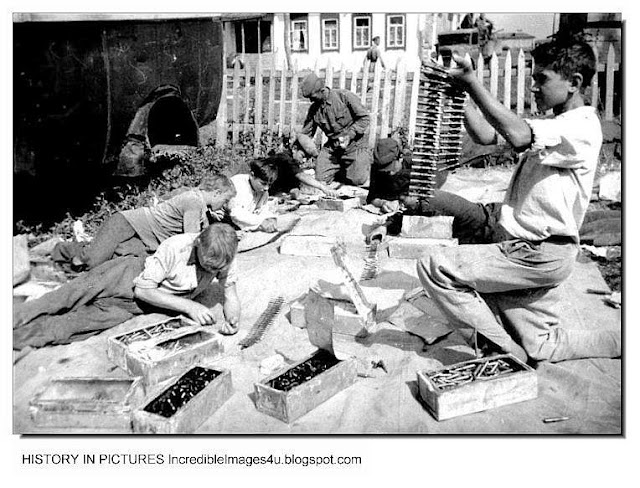Here Hitler is seen with 16 years old (he looks younger) Willi Huebner who was awarded the Iron Cross, Second Class, for his services in the recapture of Lauban in March 1945. The boy was a messenger and distinguished himself with his service.
Children also took part in military conflicts through their activity in resistance movements, for example during World War II in France, Holland, Denmark, and other German-occupied countries. In France boys were trained by the resistance movement. Older children were used as occasional informants or took part in sabotage actions. Others were instructed in how to behave in case of an inspection of the home, keeping quiet about illegal persons living in the house or apartment; others reported to the resistance movement about persons cooperating with the occupation army. The Pioneers Organization of Montenegro, founded in 1942, was for children from ten to fifteen years of age. The children helped the partisans by bringing them food, weapons, clothes, and other necessities.
Just before the end of World War II about 70,000 German refugee children (under the age of fifteen) were sent to Denmark. The children, with few exceptions, received inadequate medical care from Danish authorities. It is estimated that by the autumn of 1946 almost all the refugee children under the age of two had died. In all about 7,000 of the refugee children died in camps in Denmark through poor nutrition and lack of medical care.
In World War II, children frequently fought in insurrections. During the Holocaust, Jews of all ages, including teenagers such as Shalom Yoran, participated in the Jewish resistance simply in order to survive. Many members of the youth movement Hashomer Hatzair fought in the Warsaw Ghetto Uprising of 1943. The participation of children in this armed resistance is usually regarded as nothing short of heroic. Many other anti-fascist resistance movements across Nazi-occupied Europe consisted partially of children (for example, Szare Szeregi in Poland). A number of child soldiers served in the Soviet Union's armed forces during the war. In some cases, orphans also unofficially joined the Soviet Red Army. Such children were affectionately known as "son of the regiment" (Russian: сын полка) and sometimes willingly performed military missions such as reconnaissance.
On the opposite side, Hitler Youth (Hitlerjugend) was an organization in Nazi Germany that trained youth physically and indoctrinated them with Nazi ideology to the point of fanaticism. By the end of World War II, members of the Hitler Youth were taken into the army at increasingly younger ages. During the Battle of Berlin in 1945 they were a major part of the German defenses.
Even the Soviet Union used boy soldiers during WW2
There were no child soldiers in the Red Army during the ww2.
Some children found by Red Army soldiers without their parents in liberated areas, they were adopted, they lived with soldiers, got food, care and so on.
Soviet Union had enough adult population.
BOY SOLDIERS IN THE RUSSIAN ARMY DURING WW2
Useful Links
Books on Children and war

















No comments:
Post a Comment